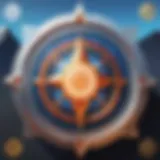In-Depth Guide to Computer Drawing Applications
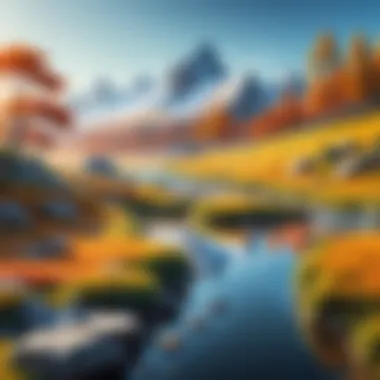

Intro
The digital canvas has transformed how art is created, offering new possibilities for expression and creativity. In this guide, we explore the various computer drawing applications that are reshaping the artistic landscape. From well-established platforms to emerging tools, computer drawing applications have become an essential part of the toolkit for both amateur and professional artists.
This exploration serves a dual purpose: to introduce newcomers to the possibilities within digital drawing, and to equip seasoned creators with insights into the functionalities that these applications offer. By delving into product features, user experiences, and technological advancements, we'll navigate the choices available to today’s artists.
As we traverse this digital territory, expect to find rich information that illuminates the complexities of each tool. The aim here is not just to inform, but to provide a comprehensive understanding of how these applications impact artistic creation. Whether you’re looking for efficiency, unique features, or community support, we’ll touch on aspects that matter.
Artists today are often caught between the traditional and the digital. Understanding this realm of computer drawing applications opens doors to innovative techniques and versatile workflows. Let's embark on this journey to uncover the features that make these applications stand out and the ways they can enhance your artistic journey.
Prologue to Computer Drawing Applications
In an age where creativity and technology mesh seamlessly, computer drawing applications have carved out a niche in the artistic landscape. Understanding these tools goes beyond mere usage; it involves an appreciation of their potential to enhance the artistic process, whether for a seasoned creator or a novice exploring their creative side.
Defining Computer Drawing Applications
Computer drawing applications are software programs that enable users to create artwork digitally. These can range from simple sketching tools to complex platforms supporting intricate layers, brushes, and features. By utilizing these applications, artists can draw, paint, and create illustrations on digital canvases. Not only do these tools facilitate a broad range of artistic expression, they also allow for the easy manipulation and modification of artwork, something traditional media cannot easily replicate.
Historical Context of Digital Art Tools
The journey of digital art tools is fascinating, weaving through decades of technological advancements. The inception of vector graphics in the 1960s was the first step down the digital path. Software such as Adobe Illustrator started taking shape in the 1980s, providing artists a new medium to explore their creativity. During the early days, programs were rudimentary and limited, often used by select professionals. Fast forward to the 1990s and early 2000s, as computing power exponentially increased and graphic tablets became commonplace, a wider audience began dipping their toes into digital art. This shift marked the transition from physical to digital, bringing forth a new era of creation and experimentation.
The Evolution of Drawing Software
The evolution of drawing software showcases technological innovation meeting artistic expression. Early iterations of drawing software were clunky and often unintuitive, leading to a steep learning curve. However, as the demand for user-friendly design grew, developers responded by enhancing user interfaces and broadening software capabilities. Today, programs like Corel Painter and Procreate provide an extensive array of features tailored to various styles and preferences. These applications support customizable brushes and tools, enabling artists to mirror traditional techniques or devise novel approaches. Moreover, the introduction of features such as layering, advanced color blending, and extensive export options has transformed the landscape. With cloud technology and AI integration becoming more common, the future promise of these applications remains even more exciting.
"The only limit to our realization of tomorrow will be our doubts of today."
Thus, as we explore this blend of technology and artistry, it's essential to recognize the critical role that computer drawing applications play in shaping the future of creative expression. The continued emergence of enhanced features and functionalities promises to redefine what's achievable in the digital realm.
Key Features of Computer Drawing Applications
When diving into the world of computer drawing applications, the key features shape the experience and effectiveness of the artist's toolkit. These features not only play a crucial role in enhancing creativity but also demonstrate how these applications can cater to a spectrum of artistic needs. Understanding these aspects permits both novice and seasoned artists to maximize their productivity and unleash their potential.
User Interface and Experience
The user interface (UI) is the very backbone of any drawing application. A well-designed UI allows artists to intuitively access tools without steering away from the creative process. Think of using Adobe Photoshop or Corel Painter; they tend to offer customizable workspaces. This is not just a gimmick. A personalized workspace can mean the difference between seamless workflow and frustration.
It's like having a well-organized toolkit; everything is within grasp when you need it. For example, artists may find themselves shifting between different brushes and colors rapidly. If the UI supports a smooth transition and quick access to these options, it saves time and reduces the mental load on the artist - essential for when creativity strikes.
A handy aspect of UI design is the responsiveness of drawing tools. When you draw, there’s little more disheartening than lag. Software like Procreate or Sketchbook focus on offering a real-time interaction to match the deftness of traditional drawing. This aspect provides an organic feel, deeply influencing how an artist connects with their work.
Brush and Tool Customization
Brushes don't just add color; they could shape realization of an artist’s vision. Customization options play a substantial role here. Beyond the typical round or square brushes, painters of the digital canvas can decide on size, opacity, and texture, allowing for a wide array of artistic expression.
For instance, in Corel Painter, the ability to create a brush from scratch or modify existing ones can truly tailor the creation process. This is where the magic happens for many artists; they can embody their unique styles.
Additionally, having access to diverse brushes empowers the artist to pull off techniques that mimic traditional media or create entirely new forms.
Layer Management
If user interface is the skeleton, then layer management is the muscle of drawing applications. Layers allow artists to compartmentalize their work, avoiding chaotic merges of different elements. The ability to create, hide, and manipulate layers is a powerful tool. Imagine layering colors and textures independently in a piece; it opens up more options when you need to go back and adjust something without starting over.
Applications such as Adobe Photoshop exemplify effective layer management. Artists can create adjustment layers to fine-tune colors without altering the original image, letting creativity flow without agonizing over mistakes. This modular approach means that artists can experiment more freely, providing a cushion against the fear of ruining their work.
Integration with Other Software
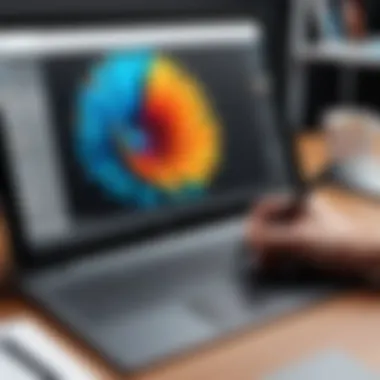

In a world where collaboration and functionality are king, the ability to integrate drawing applications with other software is paramount. Many artists rely on multiple programs to execute various parts of their creative process. For example, you might sketch in affinity designer but need to transit to Adobe Illustrator for vector manipulation.
Here, seamless integration offers not just convenience but also comprehensive capability. Features like file compatibility allow you to import and export between applications effortlessly, creating an ecosystem conducive for creativity. Furthermore, tools like cloud storage enable collaborative projects where multiple artists can contribute regardless of their physical locations. This is a game changer for both freelance professionals and teams alike!
"The best-use scenarios of drawing applications come when they harmoniously connect with other tools, maximizing creativity without boundaries."
In summary, the key features of computer drawing applications unravel the depth and complexity that empower artists. UI, brush customization, layer management, and integration stand out as noteworthy elements that shape the artist's journey into digital artistry, transforming mere software into a versatile platform that inspires creativity.
Popular Computer Drawing Applications
Understanding popular computer drawing applications is essential for anyone venturing into the domain of digital art. These programs not only allow for a canvas that can be endlessly adjusted and modified, but they also incorporate features that cater to both beginner and experienced artists. The significance lies in their versatility, enabling a broad range of artistic expressions from simple sketches to intricate illustrations. Moreover, each application tends to appeal to specific artistic styles or workflows, making it crucial for users to choose the right tool for their needs.
Adobe Photoshop: Industry Standard
Adobe Photoshop is often considered the gold standard in digital art and graphic design. Its extensive range of tools allows artists to create from scratch or manipulate existing images with remarkable precision. The software boasts an array of brushes that mimic traditional media, versatile layer management, and diverse filters. What sets Photoshop apart is its continual evolution; Adobe regularly updates the software, introducing features that keep pace with the needs of modern users.
However, it might not be the most user-friendly for newcomers, which can create a barrier for budding artists. Understanding its many functionalities can feel overwhelming, but once mastered, Photoshop can serve as a powerhouse for artistic creation.
Corel Painter: The Traditional Artist’s Tool
Corel Painter speaks to artists who long for the tactile experience of traditional painting while nurturing their digital creativity. This application offers an expansive selection of brushes and textures that replicate oils, watercolors, and acrylics. For those who have spent hours honing their skills in traditional mediums, transitioning to Corel Painter often feels like slipping into a familiar pair of shoes.
Its unique capabilities allow for a blend of traditional techniques with modern technology, appealing to artists who want to retain that authentic look in their digital work. However, it's important to remember that this application comes with a learning curve, as understanding its vast toolbox takes time.
Procreate: A Mobile Solution
Procreate has surged in popularity, especially among iPad users. Its user-friendly interface and extensive features make it a solid choice for both sketches and elaborate illustrations. Artists appreciate the ease of access to various brushes and tools, which can be tailored to suit their style. The portability provides flexibility; artists can create wherever inspiration strikes.
What makes Procreate stand out is its recording feature, allowing users to replay their artwork process step by step. This characteristic is exceptional for sharing techniques or simply revisiting the creative process. However, some artists may feel constrained by the limits of a mobile platform compared to desktop applications.
Sketchbook: Accessible Creativity
Sketchbook, developed by Autodesk, is designed with ease of use in mind. This application reflects a no-frills approach to digital drawing and is accessible for artists at all skill levels. It boasts a clean, intuitive interface that helps users focus on their creativity rather than being bogged down by overly complicated menus.
Despite its simplicity, Sketchbook offers powerful tools, including layers, customizable brushes, and perspective guides, making it a capable option for both casual doodlers and serious artists. This application is ideal for those new to digital drawing, as it can help build confidence without overwhelming them with features they might not need.
Affinity Designer: Vector and Raster Skills Combined
Affinity Designer is often heralded as a robust alternative to Adobe Illustrator, providing a unique offering that seamlessly combines raster and vector-based graphics. This functionality is appealing to a variety of artists, from illustrators to graphic designers, as it allows for an eclectic mix of styles within a single project.
Its precision tools tailored for vector art make it perfect for creating detailed designs, while the raster features accommodate more freeflowing artwork. Artists looking to produce holiday cards or logo designs might find Affinity Designer particularly handy, as it suits versatile outputs. Nevertheless, those new to graphic design may find the array of options a tad intimidating at first, but the payoff in improved efficiency and creative possibilities is well-worth it.
Benefits of Using Computer Drawing Applications
Computer drawing applications revolutionize how artists and designers create and communicate their ideas. They’re not just a fad; they represent a fundamental shift in the artistic landscape, allowing individuals to explore their creativity in ways that traditional media often can't match. This section dives into the notable advantages of using these applications, spotlighting aspects such as flexibility, cost efficiency, and accessibility. Understanding these benefits can help both budding and seasoned artists make more informed choices about their tools and workflows, ultimately enhancing their artistic endeavors.
Enhanced Flexibility and Modifiability
In the realm of digital art, flexibility reigns supreme. What sets computer drawing applications apart is their ability to allow quick adjustments. Imagine sketching an idea, only to realize the composition feels off. With traditional tools, correcting this could involve a tedious process of erasing or redrawing on paper. However, with digital software, you can easily reposition elements or modify colors with just a few clicks.
The modifiability of digital art is also noteworthy. Layers let you separate elements of your artwork, which means any adjustments you make won’t disrupt the whole piece. You can dabble with various brush styles or effects, experimenting on-the-fly without the fear of ruining your work. This notion of experimentation is crucial for artistic growth, allowing artists to push their boundaries within a comfortable and forgiving medium.
Cost Efficiency Compared to Traditional Media
When it comes down to the dollar and cents of creating art, computer drawing applications often shine brighter than traditional media. A high-quality sketchbook and a decent set of pencils can quickly lead to hundreds of dollars spent, not to mention the cost of paints, canvases, and brushes which can add up fast.
In contrast, many software options require only a one-time purchase or a subscription that provides access to a range of tools. Once you’ve got your setup sorted, the possibilities are endless. There are even free applications that offer professional-grade features, allowing artists to save their hard-earned cash without compromising on quality. This makes digital art more accessible to a larger audience, leveling the playing field for emerging talent.
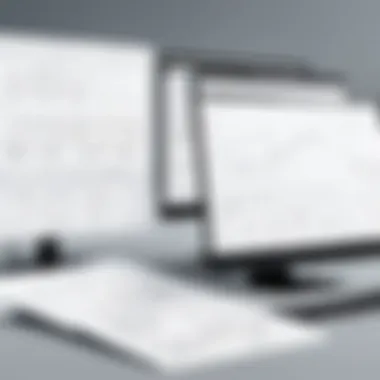

Accessibility for Beginners and Professionals Alike
What’s remarkable about computer drawing applications is their broad appeal. Whether you’re seasoned in traditional methods or just starting out, there’s something to gain. For newcomers, many applications come equipped with tutorials and community resources that simplify the learning process. It’s as if you're diving into a treasure chest of knowledge right from your screen.
On the flip side, for established artists, these applications offer powerful tools that can elevate their work significantly. They can access advanced features for fine-tuning and intricate detailing, which may not have been possible with traditional media.
Accessibility is particularly important in today's digital age. Many drawing applications sync with cloud services, enabling artists to work from virtually anywhere. Whether you're relaxing in a café or commuting on a train, your workspace is always near, thus generating potential for creativity anytime and anywhere.
"The beauty of digital art lies not only in the tools but in the freedom to explore without the fear of waste—each stroke can be a step toward genius."
The benefits articulated above highlight how computer drawing applications are reshaping artistry for a diverse audience. Their enhanced flexibility, cost efficiency, and undeniable accessibility empower artists at every level, encouraging a dynamic approach to creativity in a world that’s continuously evolving.
Challenges in Computer Drawing Applications
In the realm of digital artistry, while computer drawing applications have revolutionized the way artists create, they are not without their hurdles. Understanding these challenges helps users navigate the landscape more proficiently. The insights gleaned from this exploration are essential for anyone from a budding artist to a seasoned pro. When they grasp the potential pitfalls, users can leverage the strengths of these tools effectively.
Steep Learning Curves for Complex Software
Diving into advanced drawing software can often feel like trying to read a foreign language. Applications such as Adobe Photoshop or Corel Painter, despite their powerful features, present a steep learning curve. For instance, mastering layers, brushes, and customizable settings can bewilder a newcomer. A user might find themselves sifting through innumerable options like a needle in a haystack. While many programs offer tutorials, the abundance of features can sometimes create confusion rather than clarity.
Some artists might find the early stages frustrating. It's not uncommon for beginners to feel overwhelmed, spending more time fighting with the software than creating art. This initial struggle can lead to discouragement, potentially hindering their exploration of digital drawing. To truly harness the power of these applications, fresh users often need considerable patience and persistence.
Technical Issues and Software Bugs
Even the most sophisticated software can suffer from bugs and glitches that jeopardize the user experience. Imagine you’re in the groove, brush strokes flowing like water, only to have the application crash unexpectedly. This can result in lost work and soured moods. Users heavily reliant on their tools may encounter frustrating bottlenecks caused by slow response times or crashes. For instance, high-resolution canvases tend to push the limits on some devices, causing lag that interrupts the creative flow.
Another frequent issue stems from inadequate updates. Software developers do release patches, but sometimes bugs can linger longer than expected. This inconsistency can dismantle the creativity and spontaneity an artist seeks in their work.
Overreliance on Technology
In today's art world, it’s easy to develop a dependency on technology. As artists become accustomed to digital tools, they may find themselves leaning excessively on features like undo commands, automated brushes, and filters. This reliance can inadvertently stymie their growth and creativity. Art has always thrived on individual expression, and if artists lean too heavily on technology, they risk losing touch with their fundamental skills
Creatively, there’s a danger of falling into a comfort zone. Perhaps an artist accustomed to digital aids hesitates to experiment with traditional methods or even to improvise while using their application. The tools should enhance creativity, but not define it. It’s imperative for artists to occasionally step back, recognize these dependencies, and strive for balance to maintain their unique artistic voices.
"Art is a collaboration between the creativity of the mind and the control of the tools one uses. When that balance falters, the art may suffer."
Overall, while computer drawing applications offer immense potential, users must be aware of the challenges that come with them. Recognizing issues like steep learning curves, technical bugs, and overreliance on technology can significantly enhance one’s digital artistry journey.
Trends in Computer Drawing Applications
The world of computer drawing applications is constantly evolving, reflecting broader shifts in technology and society. Recognizing the trends in this area is crucial, not just for developers but also for artists. These trends can reshape the tools available and influence the creative process, allowing for new forms of expression and collaboration.
Rise of Cloud-based Tools
Gone are the days when high-performance drawing applications required heavy installations on cumbersome hardware. With the rise of cloud-based tools, artists can now access their favorite software from virtually anywhere. These platforms typically operate on a subscription basis, allowing users to pay monthly or yearly instead of funding a hefty one-time purchase.
Benefits of such tools include:
- Accessibility: Artists can switch devices without needing to transfer files, keeping their work synchronized across platforms.
- Lower Costs: With payment models that fit different budgets, artists can choose what works best without breaking the bank.
- Collaboration: Many cloud tools offer built-in features for sharing and collaborative work, making it easier to get feedback and enhance projects collectively.
However, challenges exist as well. Artists must deal with stable internet connections and potential concerns about data privacy. It's a delicate balancing act, weighing the convenience against the possible risks, but overall, this trend offers a fresh palette of choices for modern creatives.
Integration of AI in Artistic Processes
AI is carving a new path in the realm of creativity. Artists can now harness artificial intelligence to augment their creative process, and it's not just a gimmick. AI-driven drawing applications can analyze styles, generate suggestions, and even assist in creating artwork. This incorporation of AI can look like:
- Style Transfer: Imbuing original designs with varying aesthetics instantly.
- Automated Coloring: AI algorithms can fill in color palettes based on existing artwork.
- Design Assistance: Suggesting alterations or improvements based on user-defined criteria, streamlining workflows.
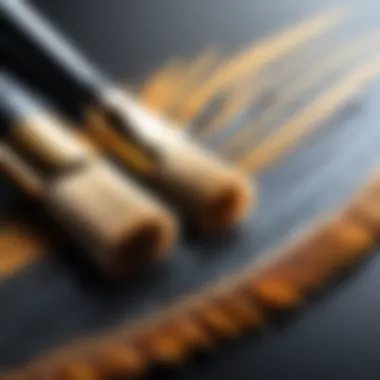

Critics argue that AI may infringe on the creative process, potentially making art too formulaic. However, many see it as a tool that empowers artists—an extension of their imagination rather than a replacement. Ultimately, AI integration in artistic processes presents a brave new world that is still unfolding, encouraging artists to explore uncharted territories of expression.
Collaboration Features for Remote Work
In our increasingly interconnected society, collaboration has taken on new significance. The latest computer drawing applications are harnessing this trend by embedding collaborative features directly into the drawing process. These features include:
- Shared Canvas: Artists can work together in real time, each contributing to a piece regardless of location.
- Commenting and Feedback Tools: Features allow team members to leave notes, share ideas, and critique designs without needing to be in the same room.
- Version Control: Tracking changes made by collaborators ensures that no good ideas fall through the cracks.
Such features resonate particularly well in industries that demand high collaboration—think game design or animation studios where teams often span multiple countries. These advancements fully utilize the power of remote work to bring talent together, efficiently merging skills and perspectives.
The integration of remote collaboration into drawing applications is not just a trend but a necessity that reflects how modern artists work today.
As these collaboration features evolve, they continue to redefine how creative teams interact, ultimately leading to richer artistic expressions.
The Future of Computer Drawing Applications
As technology continues to advance, the realm of computer drawing applications stands on the threshold of a new and promising frontier. The importance of understanding the future of these applications cannot be understated, particularly for artists who rely on them for their creative expressions. This section delves into several key aspects that will shape the trajectory of digital art tools.
Potential Developments in User Interfaces
User interface design is arguably one of the most critical factors that can influence the effectiveness of drawing applications. As we look ahead, we can anticipate several potential developments aimed at enhancing user experience. For example, the concept of personalized interfaces is gaining traction. Imagine an application that adapts its tools and layout according to the user’s preferences and past behavior. Instead of a one-size-fits-all approach, future applications may provide a dynamic workspace that adjusts in real-time based on the artist's style or project requirements.
Moreover, gesture-based controls and touch-screen capabilities are likely to evolve significantly. We might see a surge in courses or resources dedicated to mastering these intuitive gesture systems, allowing artists to create with natural movements, much like traditional sketching. This could create a more organic flow between the artist and the digital canvas.
In addition, the integration of more advanced analytics could enable software to provide tailored suggestions for brushes, colors, or even techniques based on an artist's past projects. As a series of astute choices informs the software, artists could find themselves equipped with smarter tools for their creative endeavors.
The Role of Virtual Reality and Augmented Reality
The landscape of computer drawing applications cannot be discussed without addressing the revolutionary impacts of virtual reality (VR) and augmented reality (AR). With VR, artists can immerse themselves in a 3D environment, redefining how they conceptualize and create their works. For instance, artists might find themselves stepping into their creations, manipulating elements from all angles, offering a completely new perspective on spatial relationships.
On the other hand, AR can overlay digital images onto the real world. This opens exciting opportunities for live feedback while creating, allowing artists to see how their artwork interacts with actual environments. It might even lead to applications that let users visualize their drawings on various surfaces before committing to the final piece.
These technologies not just enhance creativity but also expand the audience's perception of art. Think about collective projects where multiple artists can collaborate in a shared virtual space, bridging gaps between geographical boundaries. It’s about collaboration meeting innovation in ways we’ve not yet fully realized.
Shifting Paradigms in Artistic Creation
In contemplating the future, we must take into account the shifting paradigms within the artistic community. The rise of computer drawing applications has democratized art creation, allowing anyone with a tablet or stylus to explore their creative potential. This shift might continue to usher in new forms of artistry that blend traditional methods with modern technologies.
For instance, generative art and algorithmic composition have started to capture a niche audience. By employing coding skills alongside drawing applications, artists can programmatically generate unique pieces. This infusion of code into art could lead to entire sub-genres of visual aesthetics.
Furthermore, as educational resources proliferate—offering tutorials on everything from basic brush techniques to complex coding—more creators may discover their voice in this digital arena. Traditional barriers, like costly materials or physical space, will fade away, providing a wider range of possibilities for self-expression.
Indeed, the art landscape is transforming. With every new tool, every connection made through software, artists are finding innovative ways to tell their stories, enrich viewing experiences, and challenge established norms.
"The only limit to our realization of tomorrow will be our doubts of today." — Franklin D. Roosevelt
Closure
To circle back, the significance of delving into the arena of computer drawing applications is multifaceted. These tools have reshaped how creativity is expressed, enabling artists to push boundaries. The ease of modification, combined with unique features, brings an amalgamation of traditional practices and modern efficiencies. They empower both seasoned professionals and newcomers to explore their artistry without the limitations often found in conventional media.
Recapping the Importance of Computer Drawing Applications
Computer drawing applications serve as a bridge between imagination and execution. They allow for a level of flexibility unmatched by physical media. Artists can experiment, overlay, or completely change their work with just a few clicks or strokes. This digital canvas also encompasses tools that replicate real-world textures, colors, and effects, giving the user an expansive range to create art.
Moreover, these applications have democratized art creation. They make it accessible; anyone with a computer or tablet can create stunning visuals without needing hefty supplies or studios. This accessibility fosters greater diversity in artistic expression, providing a platform for voices that might otherwise remain unheard.
With the right computer drawing application, what is in your mind can become reality, freeing artists from the constraints of the physical world.
Final Thoughts on Digitally Enhanced Artistry
As we stand on the brink of technological evolution, it’s clear that computer drawing applications are here to stay. They are no longer just simple tools; they are evolving creative spaces where digital artists can flourish. The melding of traditional techniques with innovative functionalities reflects the ongoing shift in artistic creation paradigms.
From the integration of AI-driven tools that suggest adjustments to the collaboration features that enable real-time feedback from peers, the landscape of digital artistry is rich with opportunities. Artists must embrace these changes and adapt to new methods of creation.
